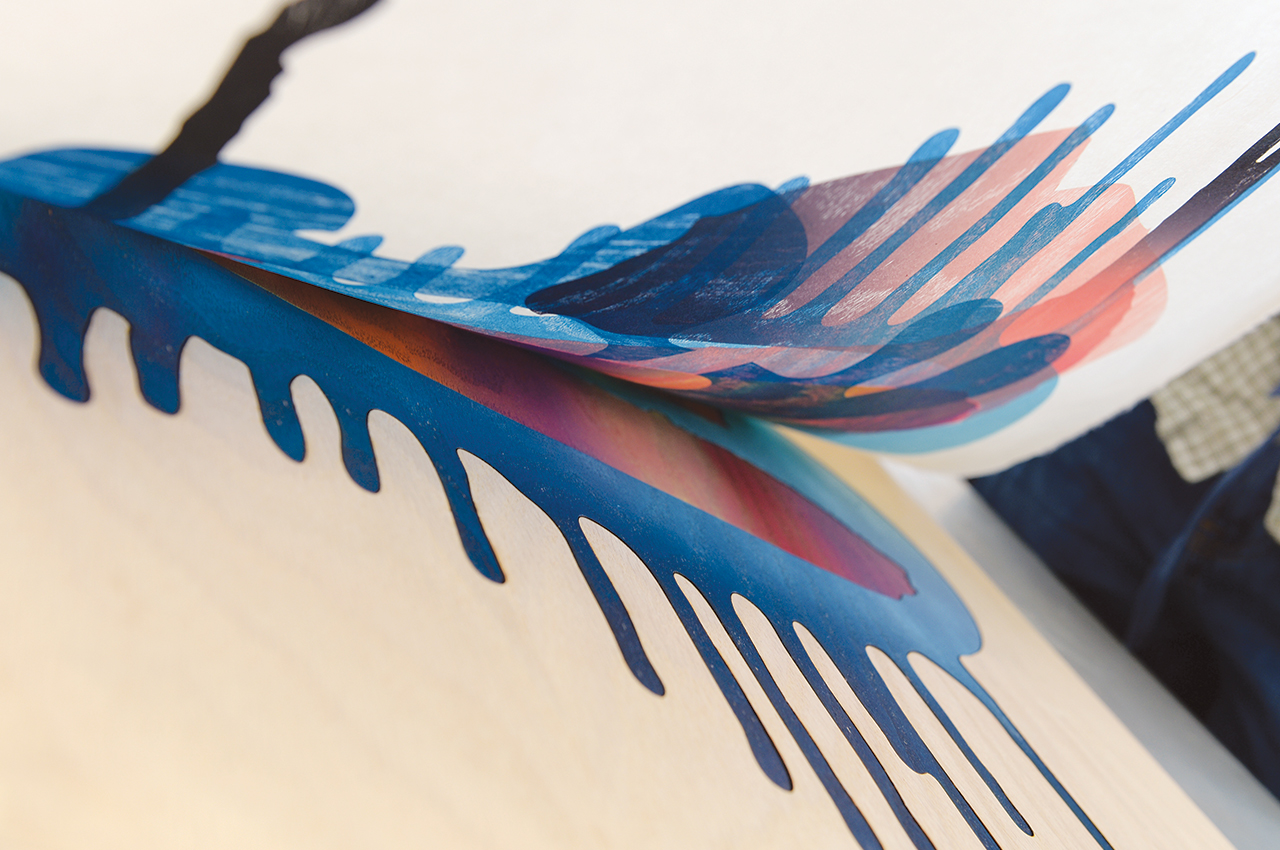Above: A print is gently peeled from the block for evaluation by artists Tim Dooley and Aaron Wilson. Working together, they explore a creative process that is complex and experimental.
Writer: Vicki Ingham
Photographer: Duane Tinkey
Andy Warhol and Jean-Michel Basquiat. Jasper Johns and Robert Rauschenberg. Marcel Duchamp and Luis Buñuel. They all dabbled in making art as teams, but those efforts didn’t define their legacy. For Cedar Falls printmakers Tim Dooley and Aaron Wilson, however, collaboration is fundamental to their work. Their prints capture a freewheeling exchange between two creative personalities who share both a common aesthetic and confidence in each other’s judgment.
Wilson and Dooley met more than 15 years ago at the University of Northern Iowa, where both teach printmaking. They were invited to lead a digital screen-printing workshop at North Dakota State University in 2001, and Dooley suggested they make a collaborative print as part of the class. Other invitations for workshops, visiting artist residencies and exhibitions followed, and gradually the work that each created independently began to seep into the work of the other. “We began to think about the entire exhibition, not ‘this is my work and that’s his,’ ” Dooley says.
Now working under the business name Midwest Pressed, they use silk-screen and relief printing in a way that, in a sense, turns printmaking on its head. Instead of producing multiples of the same image, they create a series of unique but related images. “We are not really interested in subverting the original purpose of printmaking,” Dooley says. “It simply works out that way, that the particular tone achievable with printmaking techniques is integral to the work we do. The work is a lot about the ways in which a suite can be both similar and unique, and where the boundaries are for that.”
Every new series begins with brainstorming ideas—say, “modern zombies, the walking dead of the fine art world,” says Dooley. Each artist makes multiple drawings that they scan into their computers and manipulate. They volley the digitized drawings back and forth, each adding, subtracting and changing the image.
“It’s a sort of call and response,” Wilson says. “Tim will make a move and then I will, and we go back and forth until it’s clear we need to sit in the same room and discuss what needs to happen.”
Once they’re satisfied with the image, they transfer the components to silk screens and begin a long process of printing. It’s another call-and-response conversation, with each artist adding a layer of ink and image over what the other has done. As layers build up, they evaluate the effect. “If we’re too comfortable with it,” Dooley says, “it needs another run.”
At that point, they may choose a strongly contrasting color, “to see if that finishes it,” Dooley says, “or ‘finishes’ it,” taking the print over the edge from provocative to … not so interesting. “You have to be willing to fail, basically,” Wilson says.
The goal for each print is to have the layered images “disguise and camouflage each other and make this new thing,” Wilson explains. “We’re after this unsettling juncture, that kind of unsteadiness of the layering,” that gives each print a unique character.
Dooley and Wilson see the technique as wedded inextricably to the content of the prints. Silk-screen printing is a mechanical process associated with commercial graphics, T-shirts and posters, and is therefore an ideal means of producing work based on cultural clichés. They deliberately choose subjects from popular culture that engage them as both fans and critics—Big Foot, unicorns, “Real Housewives,” for examples. “It’s hard to make fine art out of this kind of populist subject matter,” Wilson says, but that’s part of the challenge.
The influence of Andy Warhol is hard to miss; he was the first to capitalize on screen printing and kitschy themes to erase boundaries between high and low art. Wilson and Dooley explore similar territory, but from a different point of view and with different goals.
“Their imagery is so fun,” says Laura Burkhalter, who curated a 2013 exhibition at the Des Moines Art Center featuring Wilson and Dooley. “I think they look for things that culture is embracing, things people gravitate to, and they show us what we’re interested in.” What’s more, screen printing is “very democratic,” she says, and through their demonstrations and workshops, Wilson and Dooley “really bring people into the process, so it makes their work very approachable.”
Their newest body of work, “Cut Ups,” involves relief printing rather than silk screen. Inspired by the drips and ink blots of their “Futile Gesture” series, the duo turned the gestures and drips into an image that could be cut from wood with a laser cutter. The printing “block” is essentially a jigsaw puzzle of shapes that can be inked separately with one or more colors before the block is run through the press.
As with the screen prints, Wilson and Dooley build layers of transparent color with multiple passes through the press. In addition, they use a variety of rollers to apply multiple stripes of ink at one time, creating what they call super-blends—as many as 20 colors side by side on the roller, so that when the inks are spread onto the wooden shapes, the colors grade into each other, creating a shimmering effect. Applied over a woodgrain pattern, the prints suggest 17th-century Japanese woodblock prints and German Expressionism without actually quoting either.
The techniques Dooley and Wilson develop get passed along to their students, as does the experience of working collaboratively. “Collaboration isn’t for everybody,” Wilson admits, “but we want to make sure students experience it. Art is about communication, and you have to acknowledge you’re part of a larger community.”
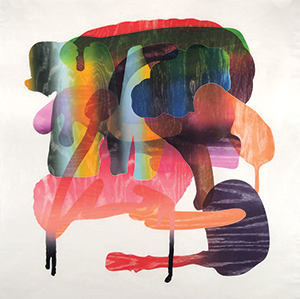
With so many layers of both ink and paper, “it is incredibly simple to ruin them,” Tim Dooley says of the work he creates cooperatively with Aaron Wilson.
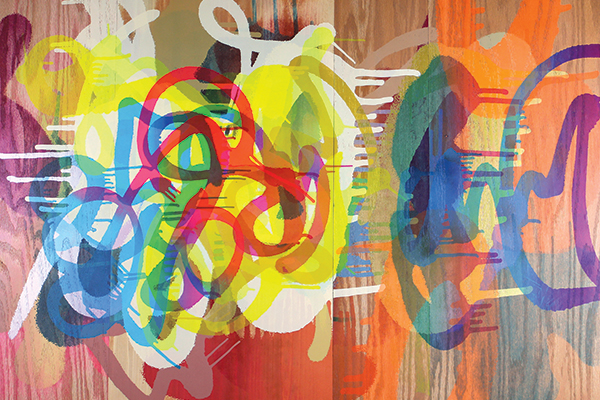
An example of screen-printed layers applied to a wooden panel, a medium the duo find intriguing. When do they agree that a print is complete? “When we feel challenged by it,” Dooley says.

Like a piece of an unfamiliar puzzle, another shape is inked and delicately placed on a work in progress.
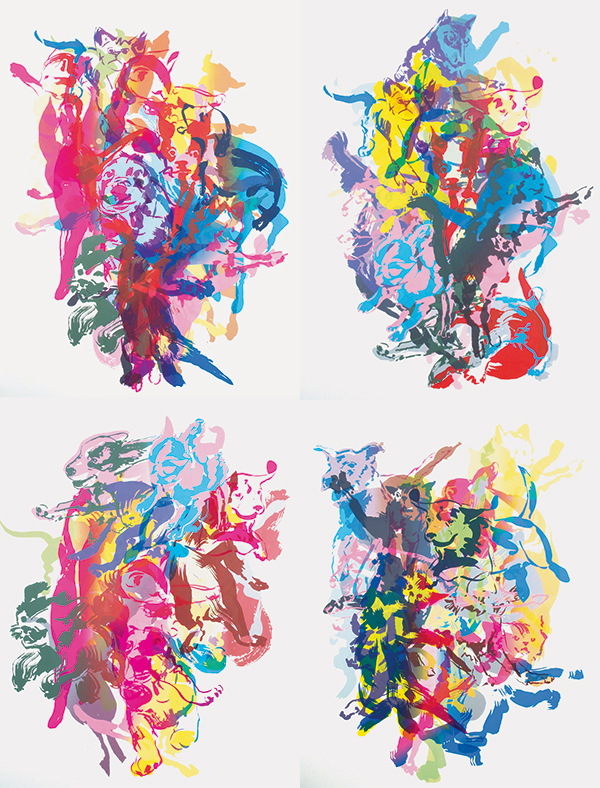
Four prints in a series called “Puppies vs. Kittens,” where playful layers of colors and forms deliver fascinating results.
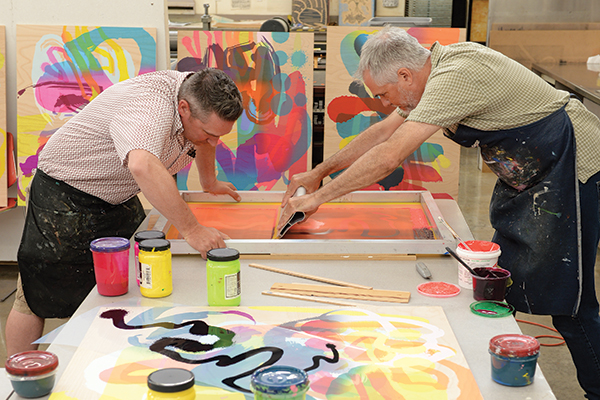
Aaron Wilson, left, and Tim Dooley at work in their Cedar Falls studio.

Titled “M.W.P. Remix #2,” this screen print collage measures 37×25 inches. It is priced at $1,200 at Moberg Gallery in Des Moines.


